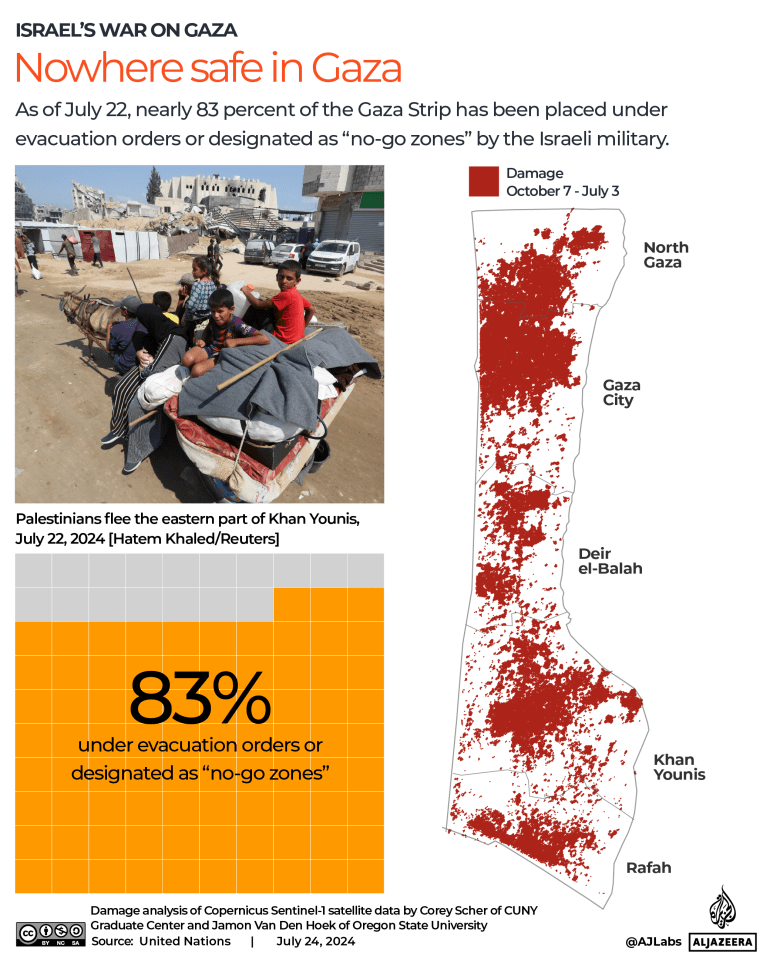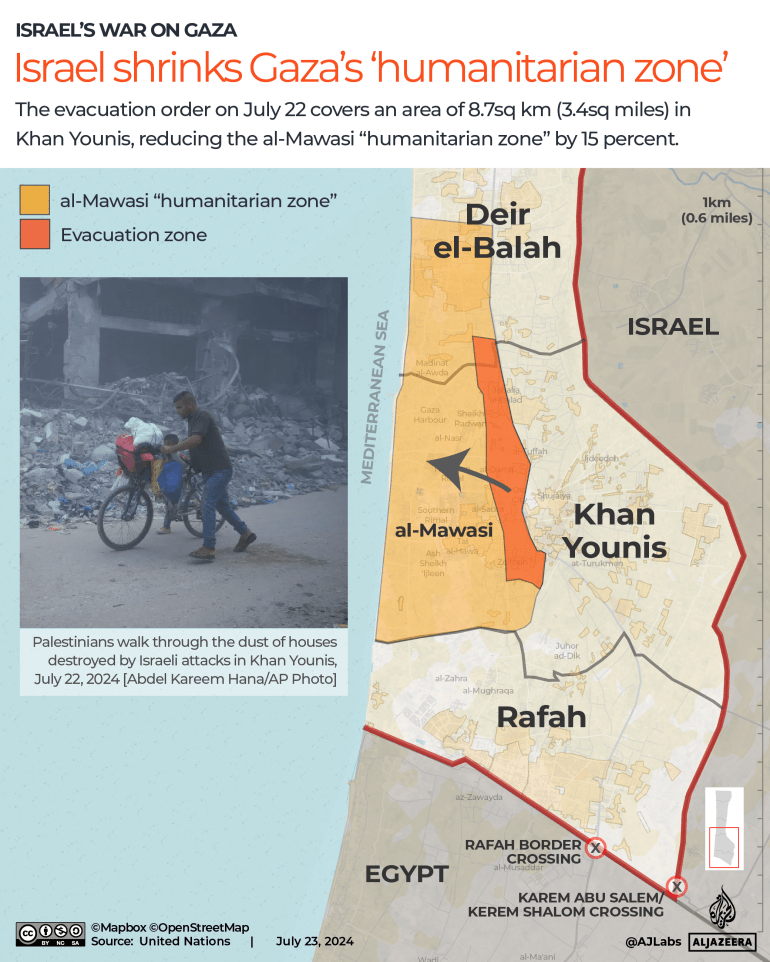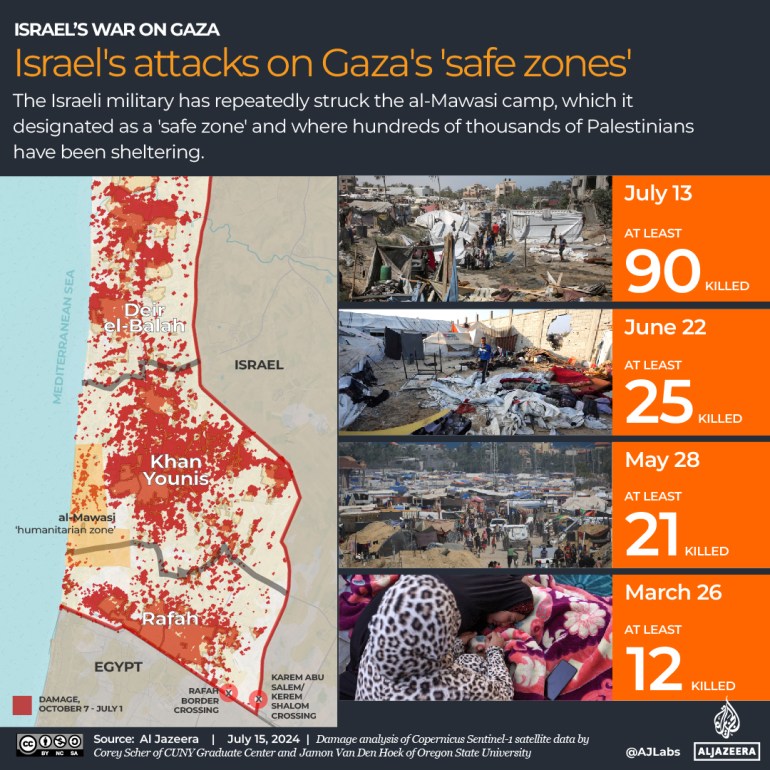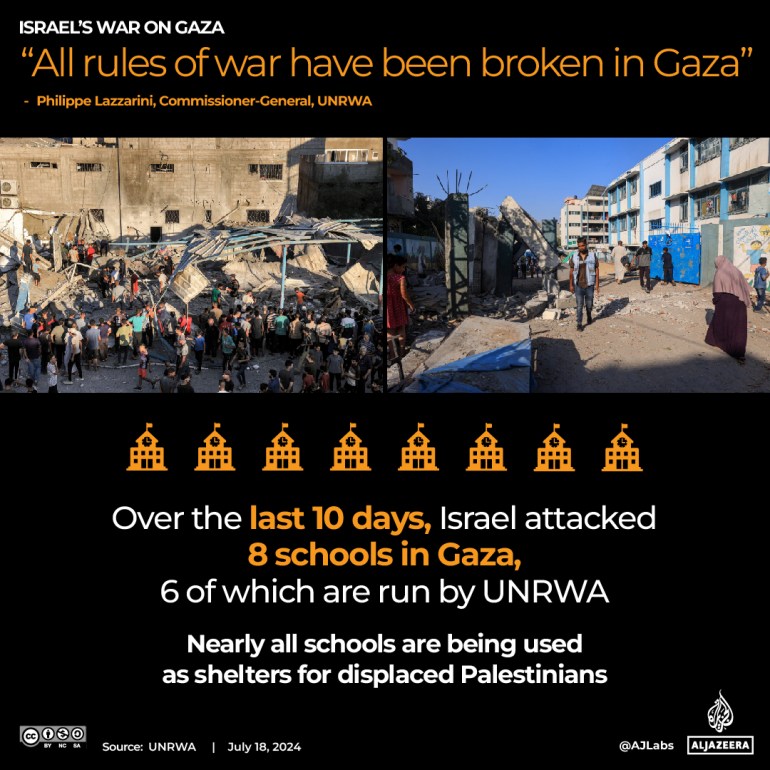EXPLAINER
Israel is declaring more and more of Gaza out of bounds for Palestinians — including parts it has called ‘safe zones’.
As of Monday, 83 percent of the Gaza Strip has been marked unsafe for Palestinian civilians by the Israeli military.
This big chunk of the beleaguered enclave has either been designated as a “no-go zone” by Israel or people there have been issued evacuation orders, according to the United Nations Office for the Coordination of Humanitarian Affairs (OCHA).
While the remaining 17 percent is not subject to evacuation orders, residents in Gaza say no place is safe as Israeli attacks throughout the Strip have continued for more than nine months. More than 39,000 Palestinians have been killed.
Since the beginning of Israel’s most recent assault on October 7, almost all Palestinians in Gaza have been displaced from their homes, some even multiple times.
Entire neighbourhoods in northern Gaza, where Israel’s offence began, have been destroyed. So-called ‘safe zones’ in southern Gaza continue to shrink and deteriorate.

Israel’s recent Khan Younis evacuation order
On Monday, the Israeli military posted on X ordering the residents of the eastern part of Khan Younis to evacuate further west in the al-Mawasi evacuation zone. The military claimed that the Palestinian group Hamas was embedded in the area.
The X post also said the call for the “temporary evacuation” was circulated via text messages, phone calls, and media broadcasts in Arabic. Over the course of the war, Gaza has grappled with internet, telecommunication and power shortages.
Due to significant terrorist activity and rocket fire toward the State of Israel from the eastern part of the Humanitarian Area in Gaza, remaining in this area has become dangerous. Accordingly, at this time, the Humanitarian Area will be adjusted. The adjustment is being carried… pic.twitter.com/bk5GGNXn6M
— Israel Defense Forces (@IDF) July 22, 2024
Less than an hour after the evacuation order, the Israeli military launched artillery and air strikes on the area, killing at least 70 people, according to Gaza’s health officials. Prior to the evacuation order, the area in Khan Younis was considered a “humanitarian area”.
According to the UN, the evacuation order forced nearly 150,000 Khan Younis residents out of their homes to areas with little or no infrastructure.
The shrinking of al-Mawasi’s safe zone
Monday’s evacuation order did not only include Khan Younis, but also about 8.7 square kilometres (3.4 square miles) of al-Mawasi, which is west of Khan Younis in the southern Gaza strip, shrinking the so-called safe zone by about 15 percent.

The area was first designated as a safe zone by Israel in early December 2023. This move was widely criticised by legal and humanitarian experts. World Health Organization (WHO) chief Tedros Adhanom Ghebreyesus deemed this a “recipe for disaster”, warning that cramming a large number of people in a small area with limited infrastructure would significantly increase health risks for those seeking shelter.
While the Israeli army initially deemed al-Mawasi a permanent safe zone, the humanitarian zone in the area has changed multiple times, and the military has attacked al-Mawasi repeatedly.
On July 13, Israeli warplanes attacked al-Mawasi, killing 90 people and injuring 300 displaced Palestinians, according to Gaza’s Ministry of Health. Two attacks took place in late June, one in May and one in February.

‘Displaced up to 10 times’
On July 4, the UN published an estimate that nine out of 10 people in Gaza have been displaced at least once. Some people have been displaced up to nine or 10 times.
Estimates suggest that 1.9 million people in Gaza are internally displaced.
Palestinians moved ‘like pawns in a board game’
Andrea De Domenico, the head of OCHA’s office in the occupied Palestinian territory, is quoted in the July 4 UN report saying: “People, in the last nine months, have been moved around like ‘pawns in a board game’ – forced from one location to the next, to the next [and] to the next, irrespective of our ability of support[ing] them and irrespective of the availability of services wherever they land.”
Is it safe anywhere in Gaza?
Over the course of the war, the Israeli military has targeted UN schools, hospitals and refugee camps, leaving no space safe in Gaza. Recently:
- On July 16, Israel bombed the sixth UN-run school in 10 days, carrying forward its deadly legacy of bombing UN schools from the beginning of the war.
- On July 18, residential buildings were hit at Nuseirat refugee camp, in Deir el-Balah, killing eight Palestinians and injuring 15, according to an OCHA update. The Nuseirat camp has recently seen a surge in violence.
- On July 20, a house was attacked in Jabalia camp’s al-Alami area. This attack resulted in the deaths of five Palestinians, including a journalist, his wife, his mother and two of his children, according to an OCHA update.
